
17 minute read
Biofuels Value Chains
7
Integrated sustainability assessment of FischerTropsch Advanced Biofuels Value Chains
Advertisement
The research activities carried out by the project on the upstream components of the value chains (feedstock diversification, harvesting, logistics) as well as on the conversion routes, delivered a series of results, that needed to be integrated into a consistent framework, to provide a comprehensive sustainability assessment of all the possible advance biofuels value chains, and to single out the most promising ones, in terms of economic and environmental performance. This work was carried out by combining an attributional perspective (developed by DBFZ) consisting of a Life Cycle Assessment and Life Cycle Costing of advanced biofuels from environmental, economic and social point of view, together with a consequential perspective (developed by IIASA), which drew potential scenarios of the environmental and land use consequences of their large-scale deployment in Europe. Life Cycle Assessment and Life Cycle Costing
In this task, a wide series of combinations of different biomass types, harvesting processes, and supply chains were considered as base assumptions, and two thermochemical routes were chosen for the initial assessment:
1. Gasification of solid biomass with a
MILENA gasifier and further synthesis of Fischer Tropsch fuels (FT diesel, FT gasoline, kerosene). 2. Production of fast pyrolysis bio-oil, followed by Entrained Flow Gasification of the bio-oil and further synthesis of FT fuels.
This generic assessment of the possible value chains helped to describe the specific benchmarking parameters and was complemented by a case study assessment,
where additional real-life parameter such as regional characteristics were considered. A life cycle cost analysis (LCC) was also carried out to complement the LCA, with the aim to analyze the costs factors affecting the biofuels and to compare them to fossil aviation fuels. All the value chains included in the LCA study achieved a GHG reduction of 65% compared to the fossil fuel reference, as required by RED II. The MILENA gasification value chains achieved a GHG mitigation potential between 65 and 80%, and the ones based on fast pyrolysis and EFG between 73% and 96%. The use of eucalyptus as biomass feedstock was associated with the highest GHG mitigation potential. The figures below show the combination of the GHG performance and the cost of fuels from the different value chains. The MILENA gasification Fischer Tropsch value chain based on giant reed resulted in the lowest production cost and the lowest GHG emissions combined, followed by the value chains using straw, sorghum and forest residues respectively, as biomass feedstock.
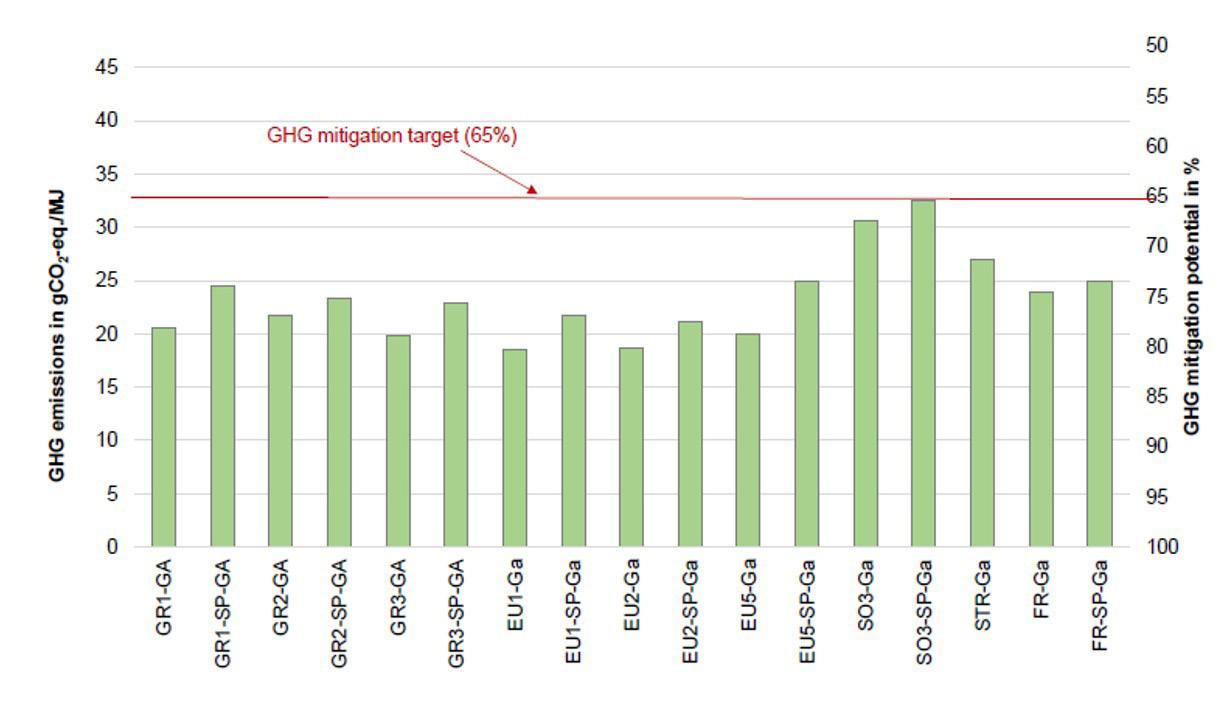
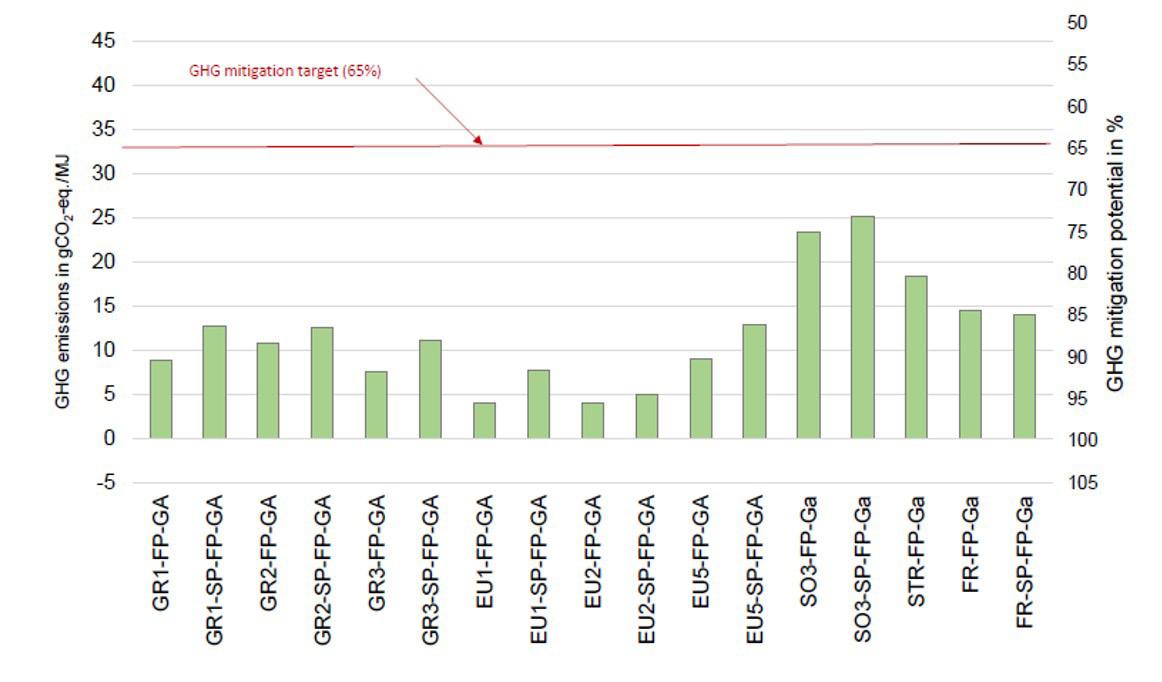
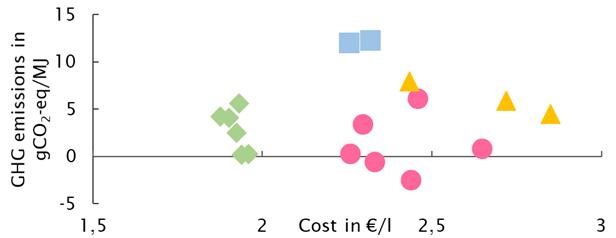
Fig 49. GHG emissions and costs for FT fuels produced with the different value chains via Milena route.
The specific GHG mitigation potential of the Fischer-Tropsch fuels was also compared to their acidifying emissions and to all other LCA relevant factors. In this example the pathways based on the use of giant reed provided the lowest GHG mitigation costs but resulted in a higher acidification potential than those based on eucalyptus and agricultural/wood residues.
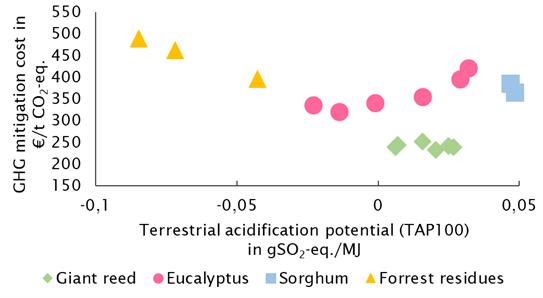
Fig 50. Comparison of the specific GHG mitigation potential for the advanced biofuel concepts to the acidifying emissions via Milena route.
The matrix below shows the results of the LCA of the most promising value chains for FT fuels from MILENA gasification. In all impact categories the performance of the advanced biofuels is significantly better than the fossil fuel alternatives.
Fig 47. GHG emisssions and mitigation according to RED II for MILENA+Fischer Tropsch (up). Fig 48. Fast Pyrolysis +Entrained Flow Gasification + Fischer Tropsch (down). Source DBFZ. (giant reed (GR), eucalyptus (EU), sorghum (SO), straw (S) and forest residues (FR), without and with slow pyrolysis (SP)).
In the route based on fast pyrolysis, entrained flow gasification and Fischer Tropsch synthesis, the eucalyptus value chains provided the highest GHG emissions savings and in some cases even achieved negative GHG emissions, while some of the giant reed value chains showed the lowest production costs and GHG emissions combined, like in the MILENA route. Contrary to the MILENA routes, the deviations here were very limited and the individual paths hardly differed in terms of acidification potential.
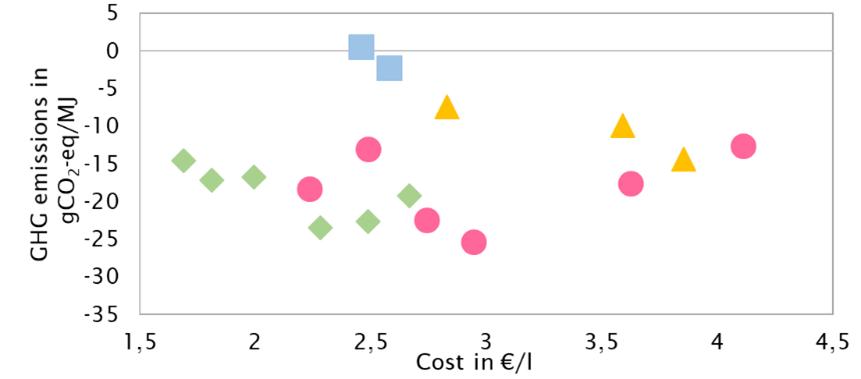
Fig 51. GHG emissions and costs for the production of the different value chains via EFG route. Land use, cost supply and emissions scenarios
With the information collected on the cropping system performance and the conversion technology requirements, a series of land use scenarios for biomass sourcing and different logistical chains were developed and evaluated in terms of cost and GHG emissions and mitigation potential.
The logistical solutions were designed and reviewed by integrating the use of different tools namely LocaGIStics, Bioloco and BeWhere and the GLOBIOM model. The combination of these tools enabled to find the optimal value chain organization, at minimum gate cost and GHG emissions, given specific biomass spatial distribution patterns within the specific bioclimatic context. Thanks to this work is possible to understand better the influence of different logistical choices on advanced biofuel value chains, the level of mobilization needed, as well as the best mix of biomass feedstock, and the implications of the regional availability and distribution of the biomass.
Value chain
Global warming potential
[gCO2eq./MJ] GR1-SP-Ga 0.2 GR3-SP-Ga 0.2 EU2-SP-Ga -0.6 SO3-Ga 12.0 STR-Ga 67.9 FR-SP-GA 4.48
GHG mitigation Costs
[€/tCO2eq]
243 239 334 364 395 489
Fossil depletion potential
[g oileq./M] 2.27 3.24 1.73 4.75 0.94 0.57
Freshwater eutrophication
[g P-eq./M]
0.023 0.023 0.021 0.040 0.021 0.019
Terrestrial acidification potential Water depletion potential RED II GHG mitigation potential
[%]
0.007 0.006 -0.023 0.050 -0.043 -0.085 0.396 74 0.519 76 0.386 77 0.485 67 0.509 71 0.298 73
Fossil Diesel 94 30 0.002 0.152 0.23 0
Table 5. LCA and LCC results matrix of FT fuels from fast pyrolysis + EFG + FT synthesis (giant reed (GR), eucalyptus (EU), sorghum (SO), straw (S) and forest residues (FR), without and with slow pyrolysis (SP), with fast pyrolysis (FP)).
The Global Biosphere Management Model (GLOBIOM) is a model developed by IIASA to assess the competition for land use between agriculture, bioenergy, and forestry. As such, the model can provide scientists and policymakers with the means to assess, on a global basis, the rational production of food, forest fiber, and bioenergy, all of which contribute to human welfare. GLOBIOM partial-equilibrium model initially developed for the impact assessment of climate change mitigation policies in land-based sectors and nowadays it is also increasingly being for agricultural and timber markets foresight, economic impact analysis of climate change and adaptation, and sustainable development goals.In BECOOL, GLOBIOM was used to assess the land use implications in biomass supply costs, emissions and profitability, as well as the land use efficiency and the impact of a large-scale deployment of lignocellulosic biomass value chains for Fischer-Tropsch fuels in Europe.
As a first step, the model assessed the land available for cropping and land abandonment trends in different scenarios and with different level of feedstock mobilization for 2030. A reference scenario was based on a pathway under the Shared Socioeconomic Pathways number 2 (SSP 2). SSPs are five scenarios of projected socioeconomic global changes up to 2100 used to derive greenhouse gas emissions scenarios with different climate policies, which were used in the elaboration of the IPCC Sixth Assessment Report on climate change. SSP2 (middle road) is the scenario in which the world follows a path where social, economic, and technological trends do not shift significantly from historical patterns. Under the SSP2, two different land use scenarios were projected, a reference scenario, aligned to the EU Reference scenario for energy, transport and GHG emissions. An alternative scenario considered a reduction of calories intake in Europeans’ diets.
In the reference scenario, up to 15.8 million hectares of abandoned land could be available in EU 27 and UK by 2030. Assuming the exclusion of 5 million hectares of High Natural Value Land set aside for conservation purposes, there is still a potential of 10.9 million hectares of abandoned land available. Considering the allocation of a share of this land to the production of lignocellulosic biomass, reasonably between 5% and 20%, the available area in the EU, suitable for short and medium rotation coppice (eucalyptus, poplar), as well as perennial crops (giant reed, miscanthus), ranges between 0.55 and 2.90 million hectares.
In the same scenarios, up to 45 million hectares of crop land used for cereals and suitable for double cropping, and 9.4 million of fallow land could be available in 2030, (excluding land allocated to conservation). Considering the same mobilization rates as above (5-20%), an area between 2.5 and 11.1 million hectares could be safely used annually, for the cultivation of lignocellulosic crops (fiber sorghum, sunn hemp), without reducing the land available for cereal crops.
Lastly, the assessment also looked at the availability of biomass from straw and forest residues, considering environmental constraints and requirements for soil carbon conservation, and a mobilization rate between 25% and 75% of the theoretical available biomass. Under these conditions, the sustainable biomass potential could range from 15.5 to 46.4 million dry tons of straw and 8.7 to 26.2 million dry tons of woody residues from forestry activities, annually.
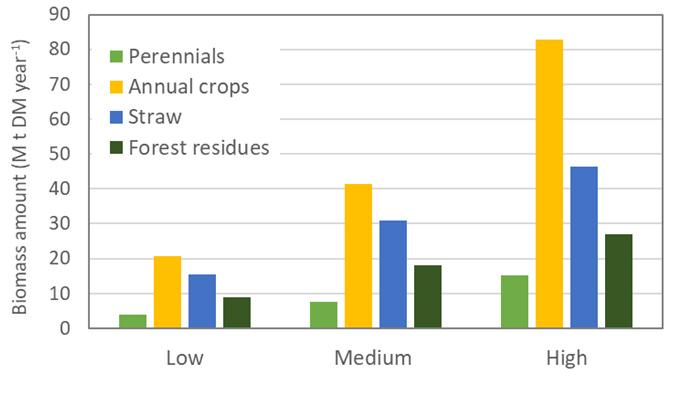
Fig 52. Biomass potentials under the three mobilization levels and the Reference scenario land use in 2030.
Cost supply curves
The assessment also calculated the cost supply curves of different types of feedstock in the reference scenario, considering spatial explicit feedstock cost at industry gate as well as the carbon emissions of delivering the it to the plant. Cost supply curves provide an indication of the theoretical amount of biomass that can be produced at different costs expressed in EUR/GJ or EUR/dry tonne. In the reference scenario for 2030 under the medium mobilization level, fiber sorghum under double cropping and cereal straw show a high potential to supply biomass under 7.5 EUR/GJ in large quantities (25 and 30 Million dry tons respectively). Sunn hemp cultivated in fallow land or as double crop also shows a significant potential, above 5 million dry tons per year at around 7 EUR/GJ.
Figure 54 below shows the amounts of biomass per year that can be mobilized considering a cut-off cost of 5 EUR/GJ, a price corresponding to a high demand condition, in the three biomass mobilization scenarios as previously calculated. In the low mobilization scenario (5% cereal land 5% abandoned land, 25% residues), around 40 million dry tons of biomass could be made available for advanced biofuels. In the medium scenario (10% cereal land, 10% abandoned land, 50% residues) more than 70 million tons of biomass could be mobilized, and finally in the high scenario (20% cereal land, 20% abandoned land and 75% residues) over 120 million dry tons of biomass could be mobilized for advanced biofuels. To reach these cumulative amounts, the combination of all types of feedstock is required, although some types of biomass play a larger role than others. The recovery of cereal straw and of forest woody residues contributes most to the cumulative potential, followed by the double cropping of sorghum after cereals, the cultivation of sunn hemp on fallow land and perennials in abandoned land. Considering that the demand of biofuels in 2030 is expected to be higher than 10 million toe, producing this amount of biofuels would require indicatively 60-70 million dry tons of biomass, and this could be achieved in the medium and high mobilization scenarios.
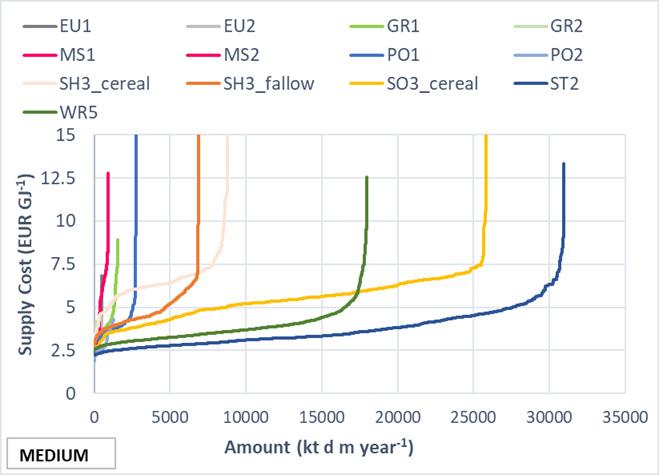
Fig 53. Cost supply curves of different lignocellulosic feedstock delivered at plant’s gate under the medium mobilization and Reference land use scenario in 2030.
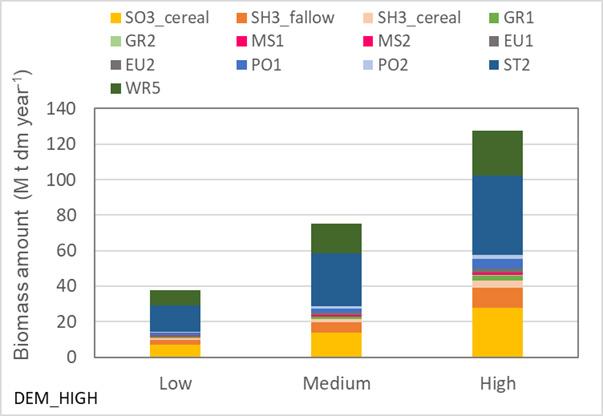
Fig 54. Availability of biomass in the Reference land use scenario 2030 with different levels of mobilization and delivery cost of 5 EUR/GJ at plant’s gate.
Spatial explicit mapping of the biomass potential
A spatial mapping of how the biomass potential is distributed across EU 27 and UK, was also carried out, considering the medium mobilization rate in the 2030 reference scenario with a competitive biomass cost of 5 EUR/GJ at plant’s gate. The mapping revealed that there are many regions with a high potential of delivering large amounts of biomass, in southern, central and eastern Europe, as shown in figure 55.
Emissions balance
The assessment also included the calculation of the net supply emissions, considering the effect of cultivation harvesting, and transportation (positive emissions), as well as the changes in soil organic carbon (negative emissions). In the medium mobilization scenario, the net supply emissions would be around 4.000 kt of CO2 equivalents per year, mainly generated by the cultivation of annual crops and the recovery of biomass residues (summing up
to more than 80% of supply emissions with the rest due to biomass transportation). However, both the cultivation of annual species (either in double cropping or on fallow land) and in particular the cultivation
of perennials on abandoned land could contribute significantly to the increase of soil organic carbon content. In the case of agricultural soils with a low initial SOC level, the progressive increase of soil organic carbon sink for crops cultivated on abandoned land could compensate the emissions from the values chain at industry gate. In the high mobilization scenario, an amount up to 3.0 million tons of CO2 eq./year could be removed from the atmosphere as soil organic carbon, compared to abandoned cropland without the introduction of lignocellulosic crops.
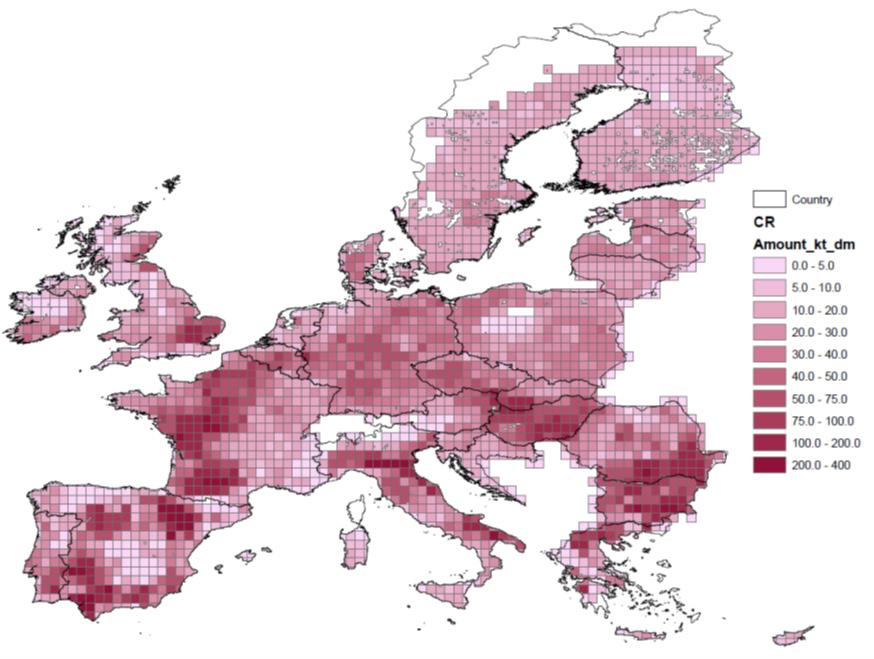
Fig 55. Regional distribution of the lignocellulosic biomass potential (k t dry matter year-1 in a ca. 50x50 km grid) under the Reference land use (2030) and medium mobilization scenario for a supply cost of 5 EUR/GJ at plant’s gate. Fig 56. Net emissions of co2 from biomass supply under three mobilization scenarios.
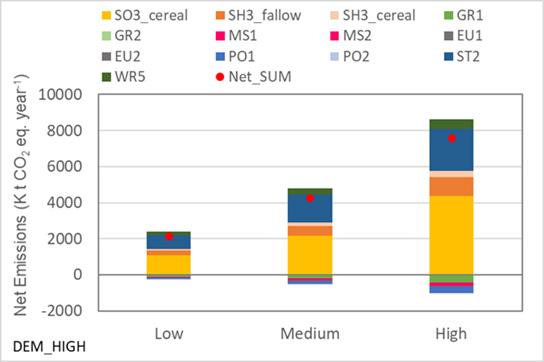
Socio-economic effects
The socio-economic effects of the deployment of lignocellulosic value chains were also assessed, considering both a profit-at-industry-gate indicator (revenuescosts) and an employment indicator. In the medium mobilization scenario up to 2030, the deployment of lignocellulosic biomass value chains (75 million dry tons of biomass/ year) could generate a cumulative profit of over 2 billion €/year, and over 25,000 full time direct jobs.
In the high mobilization scenario, more than 45,000 full time direct jobs could be created, an amount equal to about 10% of the annual working units employed by the whole forestry sector in EU 27.
Conclusions
Table 6 below shows a matrix of the results of the attributional and consequential assessments combined. All the thermochemical value chains assessed in BECOOL to produce advanced biofuels (FT diesel, FT gasoline and kerosene) meet GHG reduction target of 65% required by RED II, and up to 80% for giant reed, 96% for eucalyptus, compared to the fossil fuel reference. Therefore, their deployment can help to expand the portfolio of advanced
fuels in Europe to meet the decarbonization targets of the transport sector. This is important considering that the future biofuels demand in the EU under RED II and Fit-for-55 package can be achieved only if a significant amount of feedstock from the value chains will be mobilized.
From the point of view of GHG mitigation, the value chains based on perennial crops
cultivated on abandoned land are the most promising ones, however their projected availability in the 2030 scenarios is not sufficient to cover the expected biofuels demand driven by the current EU policy targets. Value chains based on the use of cereal straw and forest residues are less competitive than those based on perennial crops in terms of GHG mitigation potential, as they would not generate an increase of soil organic carbon content like perennials
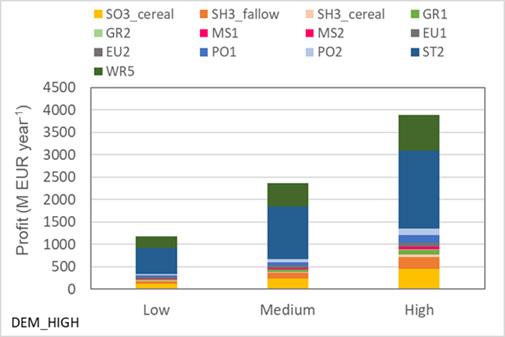
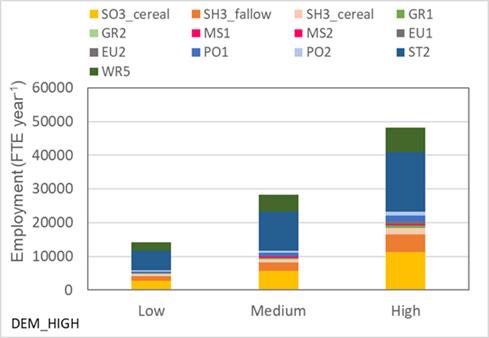
Fig 57-58. Profit and employment generated by the deployment of lignocellulosic value chains under the under the Reference land use (2030) and the three mobilization scenarios for a supply cost of 5 EUR/GJ at plant’s gate. would. In addition, although cereal residues are produced in large quantities, they often find use in traditional applications (i.e animal bedding) and their actual availability for industrial lignocellulosic plants may vary significantly at local scale.
Value chains based on annual crops such as fiber sorghum cultivated in double cropping with cereals show a very large potential in terms of biomass mobilization but could be less competitive than those based on the use of perennials and agricultural residues, in terms of GHG emissions mitigation potential.
However, the optimization of farming practices, for example by growing sunn hemp (a nitrogen-fixing legume) in rotation with fiber sorghum to reduce the need for chemical nitrogen fertilizers, can improve significantly their GHG performance. Reducing the emissions from fossil fuels used in agricultural machineries used for the cultivation of annual crops, via the optimization of the mechanized operations, or using low emission fuels in agricultural machineries (biomethane for example), could also improve the GHG performance of these value chains.
A combination of the different biomass streams (perennials in abandoned land, annual crops in double cropping with cereals and an increased use of agricultural residues), can meet the demand for advanced biofuels generated by the EU policy targets for 2030.
The adaptation of value chains combinations should need to consider the regional availability of land, including the mapping of cropland (double cropping, fallow land, agricultural residues), abandoned land suitable for recultivation (perennials) and managed forest land (forest residues).
The GHG emissions and the resulting mitigation potential of MILENA Gasification and FT value chains could be improved, by an increased share of regenerative energy in the process energy mix. For example, the integration of a slow pyrolysis process with
biomass gasification in a MILENA gasifier can be advantageous both in terms of GHG emissions and cost-competitiveness of the fuel. In this case, a slow pyrolysis plant would be used for drying the biomass and production of biochar, that could then be used either as soil amendment and for soil carbon sequestration, or directly as a feedstock for gasification.
In all scenarios the value chains often reach costs that correspond to 2 to 5 times the costs of the fossil fuel reference, these high ranges are mainly to be attributed to the complexity of the plants and the Fischer Tropsch process. However, when compared to the other lignocellulosic pathways, and especially when considering GHG mitigation costs, the costs can be competitive with the comparable pathways and are in line with the data available in scientific literature.
Since the CAPEX of the processing plant is an important cost factor for Fischer Tropsch value chains, economies of scale can effectively lower the final cost of the fuel. A reduction of up to 34% of the cost of the fuel is achievable in case of a reduction of investment costs of 50% for the MILENA gasification and FT synthesis, a target that seems as attainable in the next few years, assuming that market uptake measures and support policies are in place.
GWP Attributional perspective
GHG mitigation costs LCA (FDP, FEP, TAP100, WDP) GHG mitigation (RED II) Amount mobilized Consequential perspective
Profit before industry
Employment Net Emissions before industry Species loss reduction
EU1-SP-FP-Ga
EU2-SP-Ga
GR1-SP-Ga
GR2-SP-FP-Ga
SO3-Ga
SO3-FP-Ga
STR(St2)-Ga
STR(ST2)-FP-Ga
FR(WR)-SP-Ga
FR(WR)-SP-FP-Ga +++ o
o
o
o
o
o o
o
o
o
o
o
Table 6. Results matrix of attributional and consequential assessment of BECOOL lignocellulosic value chains (GWP - Global warming potential, FDP - Fossil depletion potential, FEP – Freshwater eutrophication, TAP - Terrestrial acidification potential, WDP - Water depletion potential; giant reed (GR), eucalyptus (EU), sorghum (SO), straw (S) and forest residues (FR), without and with slow pyrolysis (SP), fast pyrolysis (FP), gasification and FT-production (GA); +++ very good performance, ++ good performance, + performance okay, o performance).
Key points: Integrated Sustainability Assessment
• Fischer Tropsch biofuels from lignocellulosic biomass can achieve high GHG emissions reductions compared to fossil fuel reference as required by RED II, in some configurations they can also attain carbon negative emissions.
• By combining different biomass streams (perennials in abandoned land, annual crops in double cropping with cereals and agricultural residues), it is possible to meet the EU demand for advanced biofuels by 2030 with domestic supply.
• The full deployment of those advanced biofuels value chains could generate 25,000 full time direct jobs in a medium biomass mobilization scenario and up to 45,000 in a high mobilization scenario.
• The production costs of FT fuels can be competitive with the costs of other GHG mitigation options, economies of scale and industrial deployment can sensibly reduce the high CAPEX costs and the final cost of the fuels.
REFERENCES
Report on most promising value chains (D5.5) Katja Oehmichen, Fulvio Di Fulvio, Niels Dögnitz, Daniela Thrän, Nicklas Forsell, Josephin Helka, Stefan Majer. 2022
Report on Harmonized data and methodological approaches (D 5.1) Katja Oehmichen, Stefan Majer, Daniela Thrän, 2018.
Market frameworks description for liquid biofuels in road transports and aviation Stefan Majer, Katja Oehmichen, Daniela Thrän, 2019
Description of plausible value chains Katja Oehmichen, Stefan Majer, Daniela Thrän, Berien Elbersen, Bert Annevelink, Nicklas Forsell, Fulvio di Fulvio, 2018
Impact strategy for liquid biofuels in road transport and aviation. Alexandra Pfeiffer, Katja Oehmichen, Linda König, Stefan Majer, Daniela Thrän, 2019










